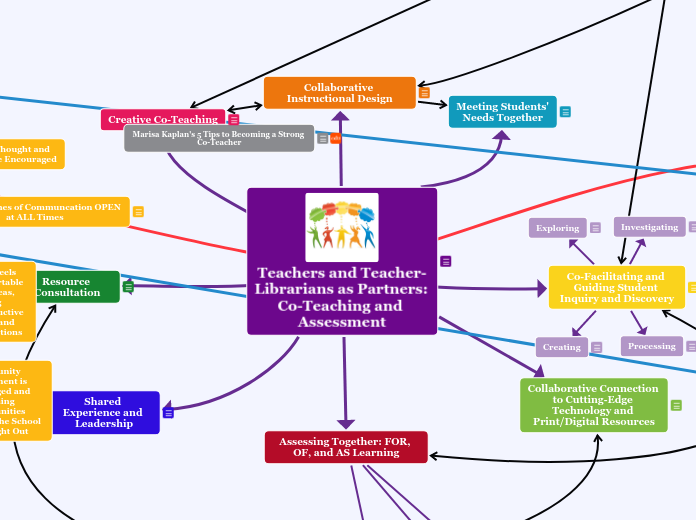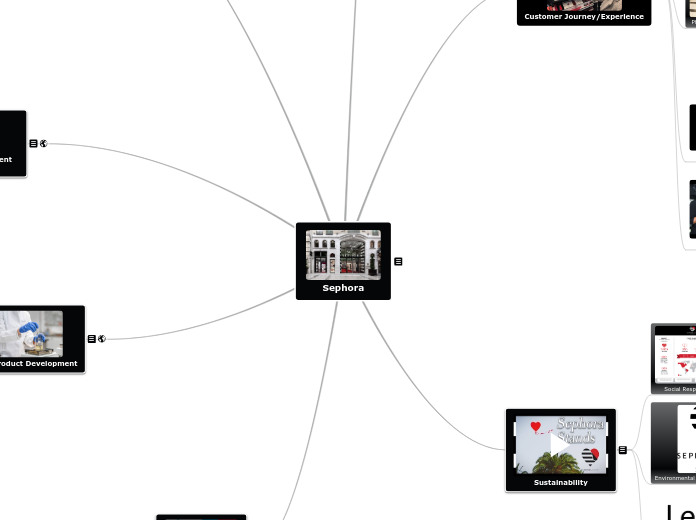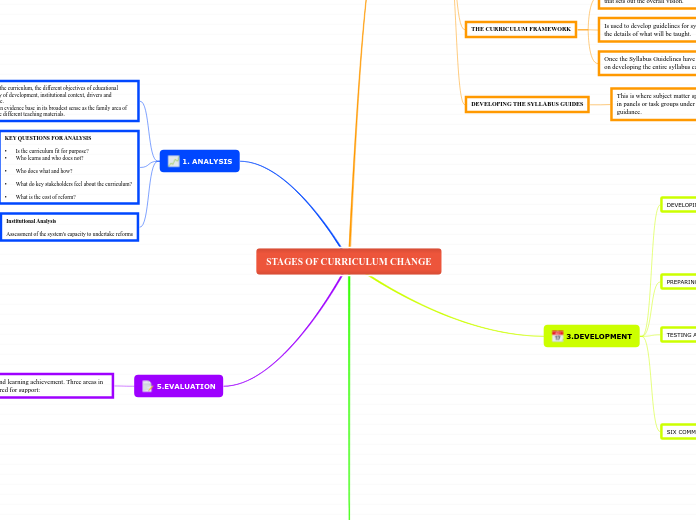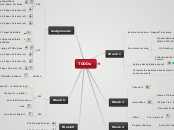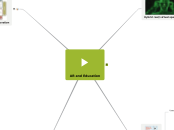"Librarians really are trained in inquiry, and inquiry lives in every single content", "Sometimes we come together, and it's even better than what we started with" (Douglas County School District 2017).
Douglas County School District. “Collaborating with Your Teacher-
Librarian.” MKG Creative Agency, 18 December 2017,
https://www.youtube.com/watch?v=Im7NcPEa2jE. Accessed 10
July 2018.
Keep the Lines of Communcation OPEN at ALL Times
At my school library, we try to create a welcoming, casual environment for classroom teachers, administration, and members of the community to come every day to have a conversation, ask a question, ask for help, or seek collaboration. We brew a lot of coffee each day, and that seems to keep our school staff coming back regularly! We're just lucky a lot of great discussion happens when we're caffeinated!
Students Feel Part of a Vital and Vibrant Learning Community that Cares About Them
Freedom of Thought and Innovation are Encouraged
Community Involvement is Encouraged and Learning Opportunities Outside of the School are Sought Out
Administration Consultation and Collaboration is Welcomed and Embraced
Everyone Feels More Comfortable Sharing Ideas, Offering Help/Constructive Feedback, and Asking Questions
Assessment Feedback for Students is More Detailed, Diverse, and Frequent
Student Learning is Improved and Enhanced in Important Ways
Creates More Unity Within the School Environment
Creates and Cultivates a More Vital Learning Community
Students Care More About What They Learn and Create
More Opportunities for Student to Reflect on, and Learn from, their Own Learning (Metacognition)
More Teachers = More Guidance, Attention, and Feedback for Students
Learning and Inquiry Skills are Improved
Student Collaboration is Enhanced
Students work together to learn, play, and innovate, and as a result, students develop helpful and inspiring “personal learning networks” (Canadian Library Association 2014).
Diverse Learning Needs are Met
Students Become More Future-Oriented and Connected to the 'Real World'
Students are more able to see the 'bigger picture' and future application of their own learning, which increases their overall engagement and motivation.
Learners are Engaged
Experiential Learning Opportunities Foster Independence and Curiosity
Interests are Targeted and Fostered
Learners are Empowered
Assessment OF Learning
Determine the students' overall level of achievement through co-constructed rubrics/assignment criteria, as well as teacher-student conferences, and teachers' anecdotal observations of the inquiry process (these may be recorded on co-constructed checklists as well).
Assessment AS Learning
Have students complete co-constructed peer and self-assessment checklists, as well as other metacognitive activities like journal reflections and exit passes.
Assessment FOR Learning
Use strategic questioning to access students' prior knowledge and/or to catalyze student inquiry, model inquiry skills, use scaffolding, and provide detailed teacher feedback.
Marisa Kaplan's 5 Tips to Becoming a Strong Co-Teacher
Marisa Kaplan's Five Tips to
Becoming a Strong Co-Teacher
- Say this mantra: "All students are our students."
- Come to planning meetings prepared (with an agenda) to maximize co-planning time.
- If you feel something, say something! Open communication is the key to a successful partnership.
- Realize that the success of your class depends on the strength of your co-teaching relationship.
- Use a variety of co-teaching models to help maintain equality.
Increased Opportunities for Students to Explore New Approaches to Learning
Teachers Form Stronger Professional Relationships that Benefit Students
Teacher-to-Teacher Transfer of Knowledge and Expertise
A Shared Responsibility for Educating All Students
Works Cited
Works Cited
Canadian Library Association. Leading Learning: Standards of Practice for School Library Learning Commons in Canada. Canadian Library Association, 2014,
http://llsop.canadianschoollibraries.ca/collaborative-
engagement/. Accessed 10 July 2018.
Douglas County School District. “Collaborating with Your Teacher-
Librarian.” MKG Creative Agency, 18 December 2017,
https://www.youtube.com/watch?v=Im7NcPEa2jE. Accessed
10 July 2018.
Kaplan, Marisa. “Collaborative Team Teaching: Challenges and
Rewards.” Edutopia, 10 May 2012,
https://www.edutopia.org/blog/collaborative-team-
teaching-challenges-rewards-marisa-kaplan. Accessed 9 July
2018.
Ontario School Library Association, et al. “The Student Inquiry
Process.” OSLA, n.d.,
http://www.accessola.org/web/Documents/OLA/
Divisions/OSLA/INQUIRY%20POSTER%20-%20English.pdf.
Accessed 10 July 2018.
Ontario School Library Association. Together for Learning: School
Libraries and the Emergence of the Learning Commons.
Ontario Library Association, 2010.
Ontario Ministry of Education. Partners in Action: The Library
Resource Centre in the School Curriculum. Ontario Ministry of
Education, 1982,
http://accessola2.com/data/6/rec_docs/partners.pdf.
Accessed 9 July 2018.
PRH Formation Développement. “Creativite.” 2014. JPEG file.
Teachers and Teacher-Librarians as Partners: Co-Teaching and Assessment
PRH Formation Développement. “Creativite.” 2014. JPEG file.
Why is a School Culture of Collaborative Teaching and Assessment so Important?
How Does This Collaboration and Co-Teaching Benefit Student Learning?
Collaborative Connection to Cutting-Edge Technology and Print/Digital Resources
It is very important for teacher-librarians to always provide classroom teachers with information regarding the most current resources that are available in the Library Learning Commons, and offer workshops (“Lunch and Learns”), as well as one-on-one assistance, to help familiarize staff with the functionality and curriculum application of new print and digital resources. Teacher-librarians can also show classroom teachers how to access visual media for their classrooms online through the school board, as well as how to access and utilize the key features of the research databases offered through the Library Learning Commons website, so that they can instruct their students through the inquiry process (or this can become an opportunity for collaboration and co-teaching). Finally, it should be a goal to position the Library Learning Commons as an engaging gateway to information that students and staff are drawn to regularly.
Assessing Together: FOR, OF, and AS Learning
Shared Experience and Leadership
It is very important to network with other educators to share experiences about curriculum areas, topics of inquiry, and helpful technology tools (This is build Responsive Professional Learning Communities). After all, the more we talk and share, the more we benefit, because we can support and advise one another. We can broaden our horizons, and feel less isolated. In addition, it is useful to keep one another informed of professional reading and professional development opportunities that may be rewarding and beneficial. Invite a teacher to accompany to you to an interesting PD session that targets one of their teachable subjects, courses, challenges, or areas of interest. Also, create a Google Doc for professional reading recommendations, as well as for leisure reading recommendations that teachers can look to when they need inspiration. In addition, take the time to listen to one another’s unique and valuable experiences, and keep in mind how they may inform ideas/changes when making decisions and when collaborating. Finally, keep in mind that it is often up to the teacher-librarian to lead the way to collaboration. According to the document, Partners in Action: The Library Resource Centre in the School Curriculum,“The positive image that the teacher-librarian projects can influence staff attitudes towards developing a working partnership” (Ontario Ministry of Education 1982). So let's strive to make the Library Learning Commons an inviting and inclusive place for students and staff to enjoy!
Creative Co-Teaching
Teacher-librarians should consult classroom teachers regarding the subject content for their course(s), and then collaborate on creative teaching techniques that could work for their group of students. In preparation, teacher-librarians can plan classroom visits with teachers either to observe successful teaching methods, activities, and subject content in action, or make suggestions/model new approaches to learning, and then together, a co-teaching lesson can be designed.
Co-Facilitating and Guiding Student Inquiry and Discovery
Co-plan special events at the library (Guest speakers, Technology Workshops, Lessons on Digital Citizenship, Makerspaces, Genius Hours, Poetry Cafes, Teacher and Student-led Book Talks, etc.). Together you can foster Discovery and Project Learning, and find a way to tie experiential learning into the curriculum and current units of study. Also, when co-teaching inquiry, ensure collaboration between teachers and the teacher-librarian at all parts of the inquiry process (Exploring, Investigating, Creating, and Processing).
Investigating
Co-create question criteria for assignments, co-create peer and self-assessment checklists, and co-model digital citizenship and digital literacy (co-teach about bias and the criteria for credible sources). Together, ask students to complete journals and exits passes to assess how students are progressing. Also, be sure to use conferencing (with the students and each other) and anecdotal notes (compare these notes with your co-teacher) to determine student understanding. Be prepared to work together to make changes as the students go through the inquiry process.
Exploring
Build on students' prior knowledge, spark curiosity, help students to devise thought-provoking and far-reaching inquiry questions that have the potential to foster deeper thinking, encourage students to make predictions on outcomes, create a collaborative virtual space for questioning, etc.
Processing
Co-teach students how to determine importance and relevance in their research and how to properly cited their sources. Co-model how to synthesize information and draw conclusions, as well as how to include a balance of perspectives and a range of sources in one's inquiry. Also, co-construct a variety of graphic organizers for students, in order to assist them in categorizing and analyzing their information in ways that appeal to them as learners. Finally, assess and evaluate students' final product based on shared conversations and observations.
Creating
Co-create rubrics together with student input (co-develop learning goals and success criteria), co-curate students' choice of topics/materials, and present differentiated approaches to inquiry that students can select from. Also, integrate student metacognition activities in conjunction with detailed and frequent teacher/teacher-librarian feedback. Finally, together, help students decide how they would like to share their inquiry (students must find interesting and exciting 'real world' avenues to showcase their learning – the goal is to find a global audience and application for their products/projects).
Resource Consultation
Through direct consultation with classroom teachers, it is essential for the teacher-librarian to develop a comprehensive collection of resources that teachers and students need, and that will be used regularly in the classroom (i.e. Chromebooks, iPads, International Baccalaureate study guides, citation guides, reference periodicals, popular fiction, etc.). One approach to making this happen is for the teacher-librarian to create a Google Doc for teachers to inform the teacher-librarian of order requests at any time during the school year. Also, teacher-librarians can acquire inter-library loans of professional materials for teachers. According to the document, Partners in Action: The Library Resource Centre in the School Curriculum,“The selection of materials to be purchased is done cooperatively by the teacher-librarian and classroom teachers.” In addition, it is essential for the teacher-librarian to “Consult with teachers who are implementing new ideas and programs and provide appropriate resources that will assist those teachers” (Ontario Ministry of Education 1982).
Collaborative Instructional Design
Together, classroom teachers and the teacher-librarian can co-design engaging learning experiences that teach content, inquiry, digital citizenship, digital literacy, “interdependence”, and so much more (Canadian Library Association 2014). According to the document, Partners in Action: The Library Resource Centre in the School Curriculum,“The teacher-librarian needs to establish a climate of communication so that cooperatively the school staff may plan the role that the teacher-librarian and the [Library Learning Commons] will play in the curriculum”, and this role should be an active one (Ontario Ministry of Education 1982). Finally, it is important to always plan with the end in mind!
Meeting Students' Needs Together
Through active collaboration, teacher-librarians can learn from classroom teachers how best to match their students with appropriate resources in the Library Learning Commons, based on students' interests, grade level, skill set, and strengths/weaknesses. According to the document, Partners in Action: The Library Resource Centre in the School Curriculum, it is best to “Discuss with the teachers the needs of exceptional students and make a special effort to ensure that the [Library Learning Commons] contains appropriate materials to meet these needs” (Ontario Ministry of Education 1982).
Main topic
